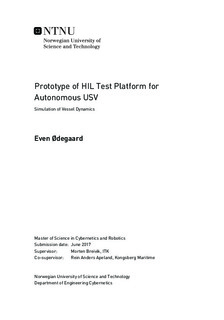Prototype of HIL Test Platform for Autonomous USV - Simulation of Vessel Dynamics
Abstract
This thesis considers the modeling of vessel dynamics and implementation of a prototype Hardware-In-The-Loop (HIL) simulator for two autonomous unmanned surface vehicles (USVs) of different dimensions in 6 degrees of freedom, including vessel, actuator, sensor and environmental models. The simulator is part of a larger HIL test platform, which also includes simulated dynamic sorroundings (Børs-Lind (2017b)). Through a versatile design, the prototype HIL test platform is implemented to fit a wide range of vessels and scenarios.
The USVs considered, Odin and Jolner, are modeled as displacement vessels in 6 degrees of freedom using basic knowledge about the vessel dimensions in combination with well known empirical formulas, conversion of parameters from similar vessels, and parameter fitting. Comparisons of results from sea trials and simulations show a satisfactory simulation model performance up to a speed where the semi-planing dynamics occur, which are not included in the vessel models. Simulation models of realistic conditions for wind, waves and current are included in the simulator, and interaction with the vessel is implemented through the use of estimated vessel parameters. Additionally, noise-free models of GPS, MRU, speed sensor and wind sensor are included in the simulator, providing realistic sensor feedback to the USV control system.
By including the real control system on Odin in the loop, testing of the HIL functionality has been performed. Vessel performance during a waypoint guidance mission is presented for both sea trials and HIL simulations, and results suggest that the interface between the simulator prototype and the vessel control system is suitable for HIL simulations.
